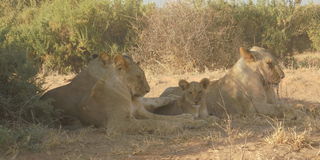Roars and trumpets in Samburu

3 Lion pride by Ewaso Nyiro Rver in Samburu National Reserve 1 Aug 2021. Photo | Rupi Mangat
What you need to know:
- Where the pastoral Samburu would have once speared lions attacking livestock, Ewaso Lions has a network of Ewaso Lions’ rangers, elders, women and children guarding their big cats
The first inkling of drought in the great North is watching the lone elephant on the banks of the Ewaso Nyiro, his toes barely covered by the water. It’s sunrise, the day still cool and my wandering gaze settles on the elephant with the tip of his trunk in the shallow, earthy water. If l thought this was exciting for the first thing in the morning at Lion King, the unpretentious little camp in the heart of Samburu National Reserve, I’m in for more.

First thing in the morning Elephant herd at Ewaso Nyiro Rver in Samburu National Reserve 2 Aug 2021. Photo | Rupi Mangat
The sound of elephants’ trumpeting comes from across the river and a dozen elephants emerge from the dry scrub. The lone male gingerly steps into the dry riverbed to meet the herd. The water is so low that it barely washes over their padded feet. For the next ten minutes, it’s just me and them – a great awakening to the African wilderness.
Then, just as suddenly as they appeared, the herd with the lone bull finish drinking and this time cross over the sandy beach into the national reserve – so quietly that the rest of the camp had no idea that the world’s largest land animal had been in their midst before breakfast.
We’re on day two of our great safari from Nairobi to the Jade Sea aka Lake Turkana, the world’s largest permanent lake in a desert. We’re taking the middle road to Turkana to reach Loiyangalani, the little village on the lake’s lush oasis-rich shores that was once a watering point for the camels of the nomadic people like the Somali, Borana, Burji, Turkana, Rendille, Samburu and other little-known tribes.
The Pride of Samburu
The Ewaso Nyiro, that is the life-lung of the arid lands, flowing from the West side of Mt. Kenya to eventually join the Jubba River in neighbouring Somalia, is not only attracting the elephants but lions too. In the heat of the day, as the wind whips up spiralling dust devils, a pride of lions rest in the shade, close to the river. So camouflaged are the cats – earth brown like the soil – that we could have driven past them. The pride has three grown-up females, a young male on the cusp of adulthood and a pair of playful cubs suckling at the females’ teats.
Despite the fact that the African lion population has declined by 43 percent in the last 20 years and lions now occupy only 8 percent of their historical range in Africa, it’s heartening to see that the lions of Samburu are doing well.
Prior to the work of Ewaso Lions in 2007, founded by Kenyan Researcher Dr Shivani Bhalla, little was known about these iconic big cats in north Kenya. At the time there were only 11 known lions in the protected national reserve. Lions were not tolerated in the wider grazing areas of the pastoral communities.
Today, there are more than 50 known lions in the greater Samburu, an area of 4,530 square kilometres of which Samburu National Park is 165 square kilometres. Where the pastoral Samburu would have once speared lions attacking livestock, Ewaso Lions has a network of Ewaso Lions’ rangers, elders, women and children guarding their big cats such that the lions, now find safe space.
Where to stay:
360 km north of Nairobi – halfway drive to Loiyangalani. It’s a small rustic eco-friendly camp, with unique crafted furniture, and great ambience. The food is delicious, a bonfire lit at by the river’s banks and a whole gamut of wildlife roaming around the small camp. Pitari’s Camp, its sister camp is in the magnificent Mathews Range, further north.
Did you know?
Today there are only 20,000 lions left in Africa. Kenya has 2,500.
According to Save the Elephants, African elephant numbers are improving but they are still endangered and their future depends on the securing wild spaces and corridors where they can move safely.
Road to Loiyangalani on Lake Turkana from Nairobi: 625 km
There is no hardship to drive into Kenya’s northern hemisphere on the Great North Road that’s the A2 that connects Africa from Cape to Cairo. Until 2017, a safari into this region that covers almost half the country was a major undertaking on untarmacked roads. Don’t rush the safari. Take time to discover the many places en route.
www.rupitheafricantrotter.com
For feedback write to the editor on [email protected]




